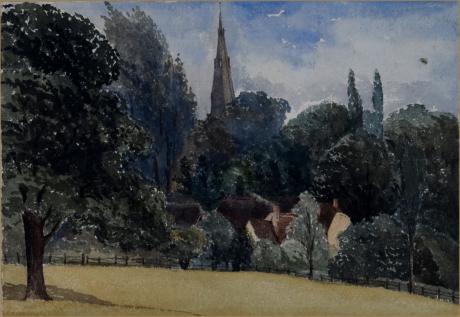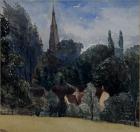inscribed in the margin " Sharnbrook Church 1874"
St. Peter's Sharnbrook is the larger of the four parishes and associated with H.E. Bates well-known character 'Uncle Silas'. It has a fine thirteenth century Church remodelled from the earlier Norman building. The river Ouse forms the Southern Boundary. Church of St Peter is a Grade I listed church in Sharnbrook, Bedfordshire, England. It became a listed building on 13 July 1964. The parish church is dedicated to Saint Peter. It is of Gothic architecture style, with a tower and spire. Its interior is decorated with monuments.
Mainly C13 to C15, with restoration of c 1855. Limestone rubble with some ashlar. Possible original Norman nave and chancel, with three bay nave rebuilt, aisles added and chancel extended in C13. C14 extensions includelarge north-east chapel and west tower, with one bay westward extensions of nave. North and south porch and several windows are C15. C17 chancel roof of three bays. C14 3-stepped sedilia and piscina in north chapel. Four bay C15 nave roof with moulded principals, carved and gilded bosses. Tower base with C15 spire and three tiers of lucarnes. C15 octagonal font. C16 screen. C17 Boteler memorial in north chapel, also Magniac memorial by William Burges 1867.
The church of St Peter in Sharnbrook is situated in a large churchyard in the middle of the village on Church Lane which leads south-east to Odell. Parking is available on the road outside the church. The church consists of a nave and chancel with north and south aisles. a north chapel and west tower and spire. There are porches to north and south although that to the north is now closed off. There are modern church rooms to the north.
The chancel is around 32 feet by 18 feet with the nave adding 46 feet by around 19 feet. The two aisles are around 9 feet in width and the north chapel is the same size as the chancel. The tower and steeple is some 15 feet by 12 feet and 132 feet high.
Whilst the church is mentioned in the Domesday book, the oldest parts date from C13, namely the two arcades and the outer walls of the aisles. The Tofte chapel to the north-east, the porches and the lower parts of the tower were added in C14. Apparently, the tower was built around 10 feet from the west end of the nave as it was then. On completion of the tower, the nave was extended to the tower. In C15, the aisles were extended westwards to the tower with additional arches placed in the arcades. There was a period of restoration and renovation in the second half of C19. The south aisle has windows to the east and three to the south; two to the east of the porch and one to the west. The east window and the two to the east of the porch are all of a similar style with the heads and tracery being modern. They are all of three cinquefoiled lights with perpendicular tracery above under four-centred arches. The south porch has a single trefoiled lancet window to the east under a square head. Like the bulk of the church the porch has a plain parapet. The western window of the south aisle, whilst restored was probably moved from elsewhere when the aisles were extended and dates from C14. It is of three trefoiled lights with quatrefoil designs in the tracery under a pointed arch.
The tower alone would suffice for most churches of this size and the octagonal spire adds extra grace. There is an internal stair in the south-west corner lit by arrow slit windows. The tower portion has a parapet pierced with quatrefoil designs with pinnacles in the corners. The belfry stage has simple uncusped two lancet openings. The steeple has three stages of lucarnes aligned to the compass points. The base of the steeple is buttressed to the corners of the tower parapet. The west side of the tower has a very low west door and west window with empty statue niches above and to the south. Symmetry doesn’t seem to have been a strong point with even the upper niche being off centre. The west window has restored tracery of three cinquefoiled lights with curvilinear tracery above under a two-centred arch.The north aisle has three north facing windows, one to the west of the porch and two to the east.The eastern and western windows or the north aisle are similar to the eastern windows of the south aisle. The centre window, whilst similar has uncusped lights with plainer tracery above.The north side of the church is now dominated by the modern church rooms which adjoin the north chapel. In the chancel are several wall monuments to members of the Gibbard family dating to C19 as well as a monument to members of the Antonie family of Colworth dating to C18.
The Tofte chapel is named after Sir William Tofte, a member of the Knights Templar in C12 who was gifted a manor house on land about ½ mile north of the church. The manor passed through various families until it was purchased in 1876 by Charles Magniac who owned Colworth House to the north-east of the church. The chapel is home to a large wall monument to the Magniac family dating to the late C19. There is also a Magniac mausoleum in the church yard. The chapel also houses a large C14 three stepped sedilia with piscine.
Sharnbrook is a village and civil parish located in the Borough of Bedford in Bedfordshire, England. The settlement was recorded in the Domesday Book of 1086 as a parish within the Hundred of Willey but was probably first developed in Saxon times. The oldest surviving building, St Peter's Church, is Norman. The name is believed to be derived from the Anglo Saxon word sharn meaning dung. Many of the older buildings in the village are constructed of the local oolitic limestone, also used in other traditional north Bedfordshire settlements. Situated just north of a loop in the River Great Ouse and almost due north of Bedford, the village has developed as a ribbon-settlement running south-east to north-west, with the core of the community clustered at the north-western end.
The village has two schools, the larger of which Sharnbrook Academy has a campus on the west of the village, serves a wide area and was attended by the marathon world record holder Paula Radcliffe, who opened the Paula Radcliffe Sharnbrook Community Sports Centre named after her in April 2005. This Community Sports Centre is not only for students but also serves the wider local community of North Bedfordshire with sporting facilities. Students are aged from 11 to 18 and take both GCSE and A Level exams. The village's other school is Sharnbrook Primary which caters for young children aged from 3–11 years old who live in the immediate area.
Another major presence is the multinational company Unilever which has a research centre on the north-western edge of the village. This uses the grounds of Colworth House, originally built in the early 17th century and rebuilt in its present form by 1774 as a private house. The house itself is used as office space, with modern laboratory buildings beside and behind it. The site is being turned into a science park for use by a number of companies.
Sharnbrook is home to Sharnbrook Women's Football Club which was established in 2002. SWFC currently play in the Beds and Herts Division 1. The club's honours include the 2006/7 Beds and Herts league and cup double and the 2015/16 Beds and Herts Division 2 league title. The team currently play on a Sunday afternoon and wear blue and red vertical striped shirts with interchangeable blue and red shorts and socks. Sharnbrook is home to many other sporting teams that both greatly predate the women's football team and significantly outstrip it in popularity.


